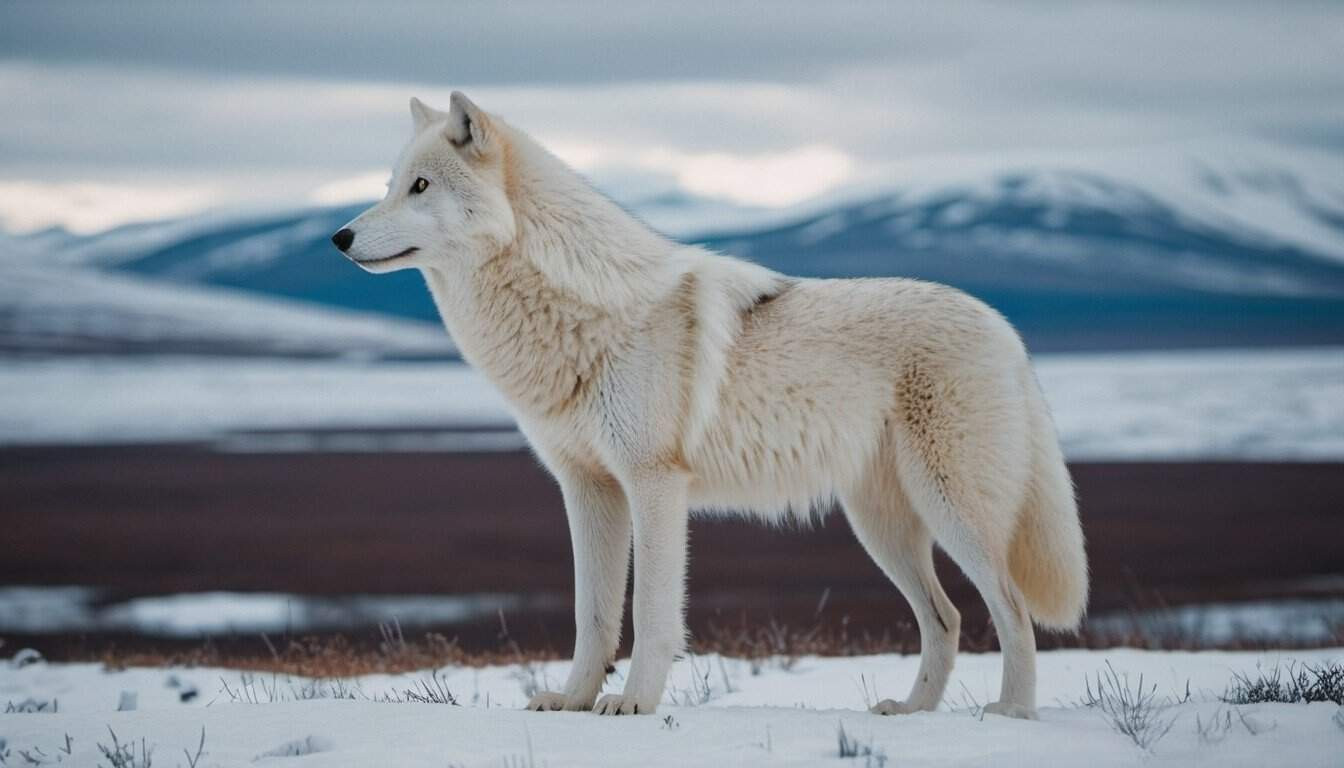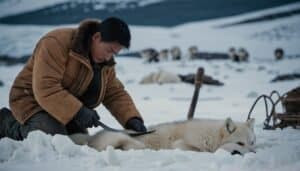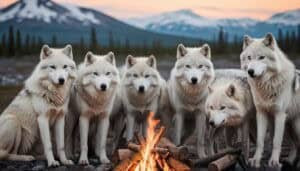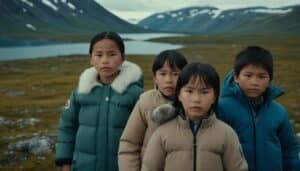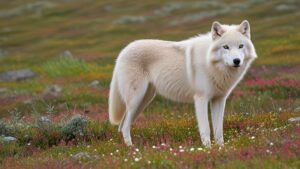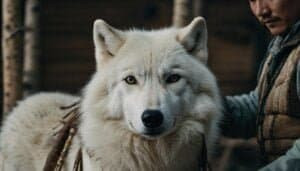Introduction
Arctic wolves hold a unique and vital role in the ecosystem, particularly as understood through the lens of indigenous knowledge
This article delves into their impact on prey populations, their contribution to nutrient cycling and biodiversity, and the cultural significance they hold in indigenous stories and rituals. It also explores traditional and modern methods indigenous people use to study these majestic creatures, as well as the observed effects of climate change on their habitats and survival strategies
Arctic Wolves and Their Ecosystem Impact
Arctic wolves, or Canis lupus arctos, play a pivotal role in maintaining the balance of the Arctic ecosystem. Indigenous knowledge, passed down through generations, provides deep insights into how these predators impact their environment
This section explores the multifaceted roles Arctic wolves have in regulating prey populations, contributing to nutrient cycling, and fostering biodiversity
Impact on Prey Populations
Indigenous communities have long observed the intricate relationship between Arctic wolves and their prey, such as caribou and muskox. Arctic wolves are apex predators, meaning they are at the top of the food chain and have no natural predators
Their hunting activities help control the populations of herbivores, which in turn affects vegetation dynamics
Traditional Indigenous Observations
Indigenous peoples have noted that Arctic wolves typically hunt the weaker or sick members of prey populations. This natural selection process ensures that the strongest individuals survive, leading to healthier herds
By maintaining a balance in prey populations, Arctic wolves prevent overgrazing and promote the growth of vegetation, which is crucial for other species in the ecosystem
Impact on Caribou and Muskox
Caribou and muskox are primary prey for Arctic wolves. Indigenous hunters and trackers have observed that wolf predation can influence the migratory patterns and behaviors of these animals. When prey populations are kept in check, it reduces the pressure on the environment, allowing plant communities to thrive
This balance supports a diverse range of species that depend on these plants for food and habitat
Role in Regulating Smaller Animals
In addition to large herbivores, Arctic wolves also prey on smaller animals such as hares and lemmings. Indigenous knowledge highlights how the presence of wolves can indirectly affect the populations of these smaller species
By controlling the number of smaller prey animals, wolves help maintain the balance of the entire food web, ensuring that no single species dominates and disrupts the ecosystem
Role in Nutrient Cycling
Arctic wolves contribute significantly to the nutrient cycling process within their habitat. When wolves hunt and consume their prey, they distribute nutrients across the landscape, which benefits various plant and animal species
Nutrient Distribution
The remains of wolf kills provide a vital source of nutrients for scavengers and decomposers. Indigenous observations reveal that animals such as ravens, foxes, and even smaller carnivores rely on the leftovers from wolf hunts
This scavenging behavior helps in the rapid decomposition of organic matter, enriching the soil with essential nutrients. These nutrients support the growth of Arctic vegetation, which in turn supports herbivores and the entire food web
Contribution to Soil Health
Indigenous knowledge also emphasizes the role of wolves in maintaining soil health. As wolves hunt and move across their territory, they inadvertently contribute to soil aeration and mixing, which improves soil structure and fertility. Healthy soil is fundamental for the growth of Arctic plants, which provide food and habitat for a multitude of species
Contribution to Biodiversity
Biodiversity is a cornerstone of a healthy ecosystem, and Arctic wolves play an essential part in maintaining it. Indigenous wisdom teaches that the presence of these predators has a cascading effect on the entire ecosystem, promoting a rich variety of life forms
Predator-Prey Dynamics
By regulating prey populations, Arctic wolves prevent any single species from becoming overly dominant. This predator-prey dynamic encourages a diverse range of species to coexist, each playing its role in the ecosystem. Indigenous stories often highlight the balance of nature, where every creature has its place and purpose
Support for Plant Communities
The influence of wolves extends to the plant communities of the Arctic. By controlling herbivore populations, wolves reduce the grazing pressure on vegetation. This allows a variety of plant species to flourish, creating a more diverse and resilient ecosystem
Indigenous practices of observing and understanding these relationships have been crucial in preserving the delicate balance of Arctic biodiversity
Interconnectedness of Species
Indigenous knowledge underscores the interconnectedness of all species within the Arctic ecosystem. Wolves are seen not just as predators, but as integral components of a larger web of life. Their presence supports a dynamic and balanced environment, where every species, from the tiniest plant to the largest mammal, plays a crucial role in sustaining the ecosystem’s health
Cultural and Spiritual Significance
Arctic wolves hold profound cultural and spiritual significance for many indigenous communities in the Arctic. They are deeply embedded in the traditions, stories, and rituals of these peoples, symbolizing various aspects of life and nature
This section explores the rich tapestry of indigenous stories and myths about Arctic wolves, their symbolism in rituals, and the valuable lessons they impart
Indigenous Stories and Myths
Indigenous narratives about Arctic wolves are plentiful and varied, reflecting the deep connection between these animals and the people who share their environment. These stories often convey moral lessons, cultural values, and historical events, serving as a means of education and cultural preservation
Creation Myths
In many indigenous cultures, wolves are featured prominently in creation myths. For instance, some Inuit stories describe how the world was shaped and populated by a great wolf spirit, symbolizing strength and resilience. These creation myths emphasize the importance of wolves as foundational beings in the natural world
Moral Tales
Arctic wolves are also central to numerous moral tales that teach respect for nature and the balance of life. These stories often depict wolves as wise and cunning animals that demonstrate the consequences of greed, disrespect, or imbalance
By sharing these tales, indigenous communities pass down important values and lessons to younger generations
Historical Accounts
Indigenous oral histories frequently include accounts of interactions between humans and wolves. These stories document the cooperation and mutual respect that often existed between hunters and wolves, highlighting the ways in which wolves have guided and aided indigenous peoples in their survival
Symbolism in Rituals
Arctic wolves are revered in various rituals and ceremonies, symbolizing different aspects of life and spirituality. Their presence in these practices underscores their importance in the cultural and spiritual lives of indigenous peoples
Ritualistic Symbolism
In many rituals, wolves symbolize protection, guidance, and strength. Shamans and spiritual leaders often invoke the spirit of the wolf to seek guidance, protection, and power. The wolf’s keen senses and hunting prowess are seen as qualities to be admired and emulated
Ceremonial Masks and Costumes
Wolves are commonly depicted in ceremonial masks and costumes used in dances and rituals. These representations are believed to channel the spirit of the wolf, bringing its qualities to those who wear them. The use of wolf imagery in these ceremonies reinforces the connection between humans and the natural world
Healing Practices
Some indigenous healing practices involve invoking the spirit of the wolf. Healers may use wolf symbols, chants, and rituals to call upon the wolf’s strength and healing abilities. These practices highlight the wolf’s role as a spiritual guide and protector in times of illness and adversity
Teachings and Lessons
The wisdom of indigenous peoples includes valuable teachings about Arctic wolves, encompassing their behavior, ecology, and the interconnectedness of all life. These teachings provide a holistic understanding of the role of wolves in the ecosystem and offer insights into sustainable living
Behavioral Observations
Indigenous knowledge about wolf behavior is extensive and detailed. Communities have observed and documented the social structures, hunting strategies, and communication methods of wolves over generations. This deep understanding of wolf behavior is used to manage and coexist with wolf populations effectively
Ecological Balance
Indigenous teachings emphasize the role of wolves in maintaining ecological balance. By regulating prey populations and promoting biodiversity, wolves are seen as crucial to the health of the ecosystem. These lessons highlight the importance of respecting and protecting all species to maintain the natural order
Sustainable Coexistence
Indigenous peoples have long practiced sustainable coexistence with wolves. They understand that the health of wolf populations is intertwined with the health of the entire ecosystem
By living in harmony with wolves and other wildlife, indigenous communities demonstrate sustainable practices that can serve as a model for modern conservation efforts
Indigenous Knowledge and Study Methods
Indigenous knowledge systems encompass a wealth of information about Arctic wolves, accumulated through centuries of close observation and interaction
This section delves into traditional tracking techniques, the role of oral histories and storytelling in preserving wolf knowledge, and the modern adaptations of these traditional methods
Traditional Tracking Techniques
Indigenous peoples have developed sophisticated tracking techniques to study Arctic wolves, relying on keen observation skills and an intimate understanding of the natural environment
These techniques provide insights into wolf behavior, movements, and interactions with their ecosystem
Footprint Analysis
Indigenous trackers are adept at reading wolf footprints, or tracks, in the snow. They can determine the age, size, and health of a wolf from its footprints, as well as its speed and direction of travel. This skill allows them to monitor wolf populations and movements accurately
Scat Examination
Examining wolf scat (feces) is another traditional method used to gain information about wolf diets and health. Indigenous trackers can identify the types of prey consumed, assess the wolf’s nutritional status, and even detect signs of illness or parasites
Behavioral Signs
Indigenous knowledge includes understanding various behavioral signs left by wolves, such as scent markings, scratches on trees, and resting places. These signs provide clues about territory boundaries, social hierarchies, and breeding status, helping trackers build a comprehensive picture of wolf ecology
Oral Histories and Storytelling
Oral histories and storytelling are vital for preserving and transmitting indigenous knowledge about Arctic wolves. These narratives are rich in ecological information and cultural significance, serving as a living repository of wisdom
Generational Knowledge
Indigenous communities pass down knowledge about wolves through stories told by elders. These stories often include detailed observations of wolf behavior, migration patterns, and interactions with other species. By sharing these stories, each generation builds on the knowledge of their ancestors, ensuring its continuity
Cultural Context
Stories about wolves are often woven into the cultural fabric of indigenous life, providing lessons on respect, cooperation, and balance. These narratives emphasize the moral and ethical dimensions of living in harmony with nature, reinforcing community values and guiding behavior
Educational Role
Storytelling serves an educational role, teaching younger members of the community about the importance of wolves and the need to protect them. Through engaging and memorable tales, children learn to appreciate the complex relationships between wolves, their prey, and the environment
Modern Adaptations of Traditional Methods
While traditional methods remain invaluable, indigenous communities have also adapted modern technologies and scientific approaches to enhance their understanding of Arctic wolves. This blending of old and new techniques provides a comprehensive approach to wolf study and conservation
GPS Tracking
Indigenous researchers increasingly use GPS collars to track wolf movements over vast distances. This technology allows for precise monitoring of wolf territories, migration routes, and interactions with human settlements
The data collected through GPS tracking complements traditional knowledge, providing a broader perspective on wolf ecology
Camera Traps
Camera traps are strategically placed in wolf habitats to capture images and videos of wolves in their natural environment. These devices help document wolf behavior, pack dynamics, and interactions with other wildlife without disturbing the animals
Indigenous trackers use these visual records to validate and expand their observational insights
Collaborative Research
Indigenous communities often collaborate with scientific researchers to conduct comprehensive studies on Arctic wolves. These partnerships combine traditional ecological knowledge (TEK) with scientific methodologies, leading to more robust and informed conservation strategies
By integrating indigenous perspectives, these collaborations ensure that research is culturally relevant and respectful of indigenous ways of knowing
Climate Change Effects
Climate change poses significant challenges to Arctic ecosystems, and Arctic wolves are not exempt from its impacts. Indigenous communities, with their extensive knowledge of the land and its inhabitants, have observed and documented changes in the environment that affect Arctic wolves
This section explores the effects of climate change on Arctic wolf habitats, prey availability, and their adaptation and survival strategies from an indigenous perspective
Indigenous Observations of Habitat Shifts
Indigenous peoples have a deep connection to their environment and are often the first to notice subtle changes. Their observations provide critical insights into how climate change is altering Arctic wolf habitats
Thawing Permafrost
One of the most noticeable impacts of climate change in the Arctic is the thawing of permafrost. Indigenous communities report that thawing ground affects the availability of den sites for wolves. Traditionally stable and secure dens are becoming less reliable, forcing wolves to relocate more frequently and impacting their reproductive success
Shrinking Ice Cover
The reduction in sea ice has profound effects on Arctic wolves, particularly those that inhabit coastal regions. Indigenous hunters have noted changes in the movement patterns of both wolves and their prey, as shrinking ice forces them to adapt to new hunting grounds and migration routes
This can lead to increased competition for resources and alter predator-prey dynamics
Vegetation Changes
Warming temperatures are causing shifts in vegetation patterns, with shrubs and other plant species moving northward. Indigenous knowledge highlights that these changes affect the distribution and abundance of herbivores like caribou, which in turn impacts wolf populations
Wolves must adapt to changes in prey availability and distribution, which can influence their hunting strategies and territory sizes
Changes in Prey Availability
Climate change affects the availability and distribution of prey species, which directly impacts Arctic wolves. Indigenous observations provide valuable insights into these dynamics
Caribou and Muskox Populations
Indigenous hunters have noticed fluctuations in caribou and muskox populations due to changing climate conditions. For instance, warmer winters can lead to ice crusting on the snow, making it difficult for herbivores to access vegetation. This can lead to malnutrition and lower reproduction rates in prey species, reducing food availability for wolves
Small Mammals
Changes in snow cover and temperature also affect the populations of smaller mammals such as lemmings and hares. Indigenous knowledge indicates that these species are crucial for wolves, especially during times when larger prey are scarce
Fluctuations in small mammal populations can force wolves to expand their hunting ranges or adapt their diets, impacting their overall health and survival
Migratory Patterns
Indigenous communities have observed shifts in the migratory patterns of prey species, influenced by changing temperatures and vegetation. These changes can disrupt the timing of predator-prey interactions, leading to mismatches in availability
For example, if caribou migration occurs earlier or later than usual, wolves may struggle to find adequate food during critical periods
Adaptation and Survival Strategies
Despite the challenges posed by climate change, Arctic wolves exhibit remarkable resilience and adaptability. Indigenous knowledge provides insights into how these animals are coping with environmental changes
Flexible Diets
One of the key adaptation strategies of Arctic wolves is their ability to alter their diets based on available resources. Indigenous observers have noted that wolves will consume a wider variety of prey, including smaller mammals, birds, and even fish when traditional prey is scarce
This dietary flexibility is crucial for survival in a changing environment
Territorial Shifts
Wolves are known to adjust their territories in response to changing prey distributions and habitat conditions. Indigenous trackers have documented instances of wolves expanding their ranges or shifting their territories to areas with more abundant food sources. This adaptability helps wolves maintain their populations despite environmental fluctuations
Behavioral Changes
Indigenous knowledge highlights that Arctic wolves may exhibit changes in behavior to cope with new challenges
For example, wolves may alter their hunting techniques, collaborate more closely in packs, or even change their denning habits to adapt to thawing permafrost and other habitat changes. These behavioral adaptations are essential for their continued survival in a rapidly changing Arctic
Genetic Diversity
Indigenous perspectives also emphasize the importance of maintaining genetic diversity within wolf populations. Genetic diversity enables wolves to adapt to new environmental conditions and resist diseases
Indigenous conservation efforts often focus on protecting diverse habitats and ensuring the connectivity of wolf populations to promote genetic health and resilience
Conclusion
Arctic wolves play a crucial role in the Arctic ecosystem, a role that is richly understood and preserved through the knowledge and traditions of indigenous peoples
From regulating prey populations and contributing to nutrient cycling, to fostering biodiversity and maintaining ecological balance, these apex predators are integral to the health of their environment. Indigenous knowledge, passed down through generations, provides deep insights into these dynamics, emphasizing the interconnectedness of all species and the importance of living in harmony with nature
The cultural and spiritual significance of Arctic wolves in indigenous communities further highlights their value beyond just ecological functions. Through stories, myths, and rituals, wolves are revered as symbols of strength, guidance, and balance. These cultural practices not only preserve vital ecological knowledge but also reinforce community values and ethical relationships with the natural world
Indigenous methods for studying Arctic wolves, including traditional tracking techniques and oral histories, combined with modern scientific approaches, offer a comprehensive understanding of these animals. This blend of knowledge systems is crucial for effective conservation efforts, ensuring that wolf populations are monitored and protected in culturally respectful and scientifically robust ways
Climate change presents significant challenges to Arctic wolves, affecting their habitats, prey availability, and survival strategies. Indigenous observations and insights are essential for understanding these impacts and developing adaptive strategies. By recognizing and integrating indigenous knowledge into conservation planning, we can better support the resilience of Arctic wolves and the ecosystems they inhabit
The role of Arctic wolves in the ecosystem, as understood through indigenous knowledge, underscores the importance of preserving both natural and cultural heritage. The wisdom of indigenous peoples provides invaluable lessons for sustainable living and highlights the need for a holistic approach to conservation that respects and incorporates traditional ecological knowledge
